Monotony and patterns are unlikely to please the eye. Everywhere dull standard fences made of corrugated board - no fantasy. Yes, inexpensive, but like everyone else and without a twist. Meanwhile, every owner wants to make his home attractive and special - this is how our nature works. And in search of interesting solutions, it is sometimes better to return to the past - to those times when there was no corrugated board and standard solutions. That is, it is time to do something with your own hands. Wicker fences - that's what really stops the eye and attracts with its originality. Moreover, there are wonderful ideas that allow you to use modern materials and make weaving so unique that neighbors will start taking selfies against the background of your fence. Let's see examples and options for making such a fence.
Read in the article
- 1 This is not a basket for you, although ...
- 2 How to make a wicker fence from natural rods
- 2.1 What you need to make a wicker fence
- 2.2 How to properly prepare wattle rods
- 2.3 Wicker fence posts
- 3 Fence weaving options
- 3.1 Plain horizontal weave
- 3.2 What is the secret of vertical weaving
- 3.3 Unusual options for weaving a fence
- 4 Examples of wicker from different materials
- 5 Care and decoration of a wicker fence
This is not a basket for you, although ...
Everything related to weaving is primarily associated with baskets. But, for your information, the fence can be made not only from the vine. With a minimum set of woodworking skills, it can be built from boards or other materials, including synthetic ones.
For example, in the houses of Austria, the idea was spied on to make fences from thin pine boards. The thickness of the board is 1.5–2 cm, and the width is 10 cm.
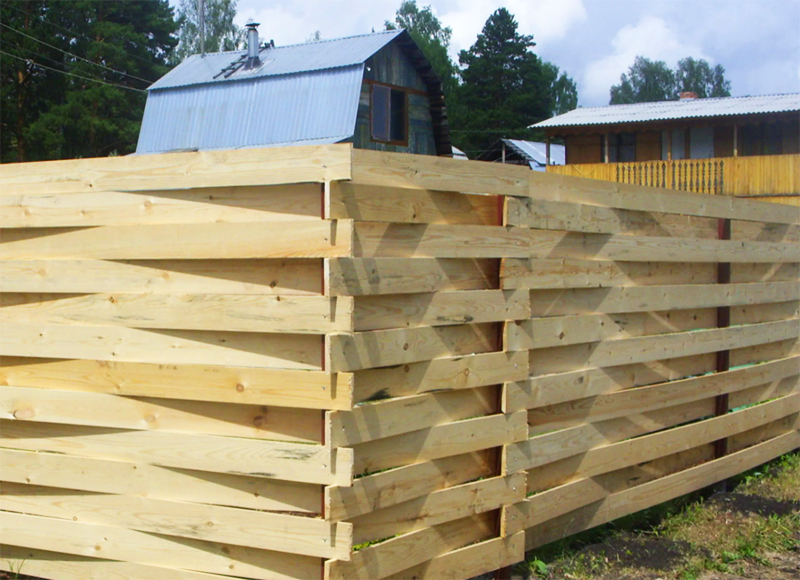
Pine boards are highly resinous, making them very durable, and with pre-treatment with an antiseptic and insect repellant, a pine fence can last almost a century. As supports for such a fence, a strong beam of 8 x 8 cm is used, but if you want to build for centuries, then profiled pipes will be the best choice for pillars.
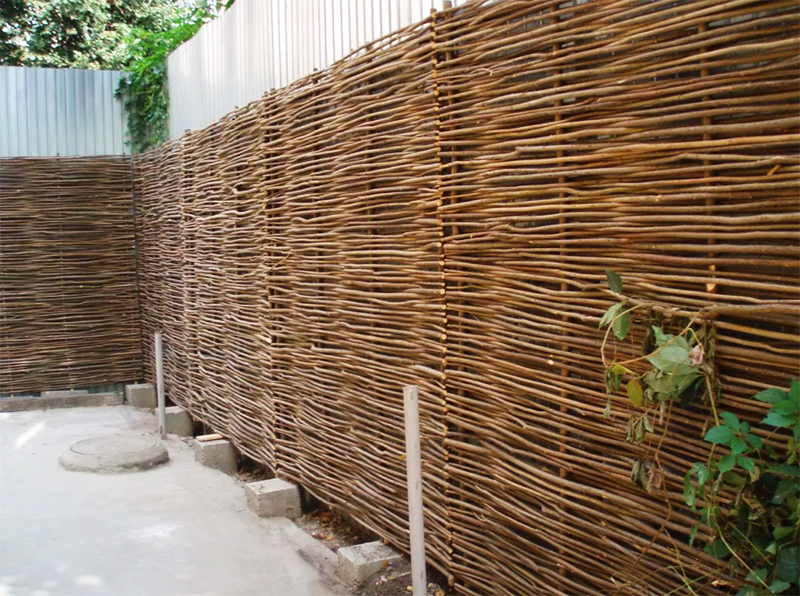
By the way, weaving from boards or vines looks good in combination with stone pillars. This, of course, is troublesome and quite expensive - to make such a capital frame, but for a long time. And weaving in this case can be carried out according to the principle of shields, that is, so that it is convenient, if necessary, to remove them for repair or replacement.
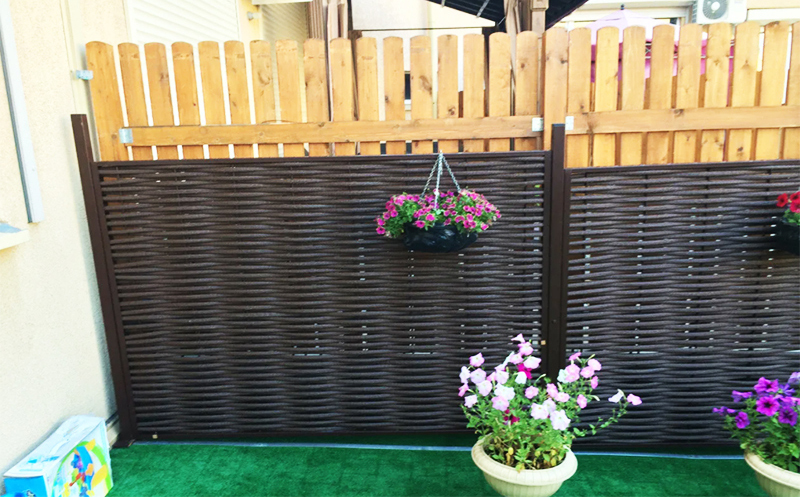
Finally, the most traditional but time-consuming wicker fence design is the vine. Yes, you will have to tinker and spend a lot of time collecting and preparing the material, but the result is worth it. The most durable wattle fences are obtained from hazel and willow branches. Willow, of course, is preferable, it is not in vain that it is the main material for any type of weaving. Flexible branches are easy to process, have a dense core and retain their strength for a long time after complete drying.
How to make a wicker fence from natural rods
The advantage of making a wicker fence from willow twigs is that the material can be obtained literally for free.
What you need to make a wicker fence
Another positive side of making wattle is that you don't need any special tools. You can do without assistants or, if you wish, involve a family in the work, including children - this work is so simple.
The most physically difficult stage is the installation of pillars. You will need a shovel or, ideally, a drill.
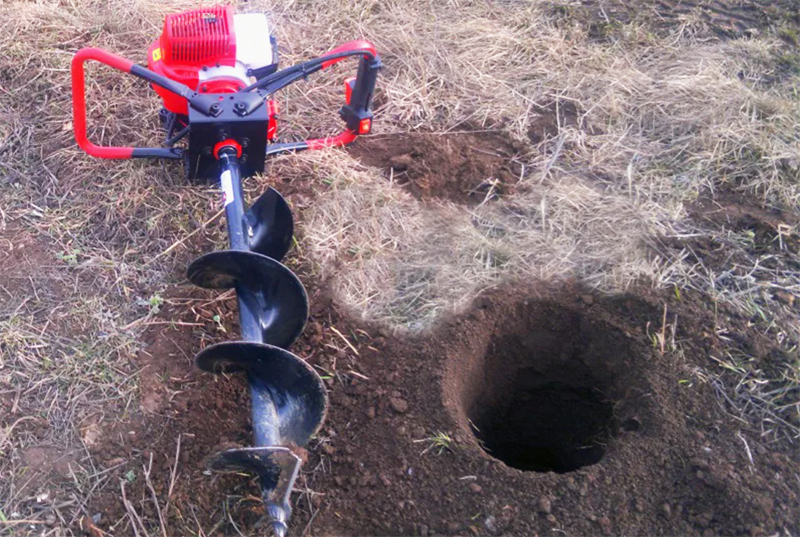
Another of the tools you will need a building level - to align the supports. And finally - a good strong construction knife for working with rods. That, in fact, is all. Be sure to use gloves or mittens.
How to properly prepare wattle rods
There is a certain time of the year for harvesting the rod - early spring or late autumn. The reason is that at this time the vine has no foliage, it is at rest, but retains its flexibility.
For the manufacture of wattle from wicker, you need to choose shoots with a thickness of 1 to 3 cm. Thin ones are too fragile, and the fence of them will be fragile and short-lived. However, if you are thinking about how to make wattle for a flower bed, then thin branches will also fit.
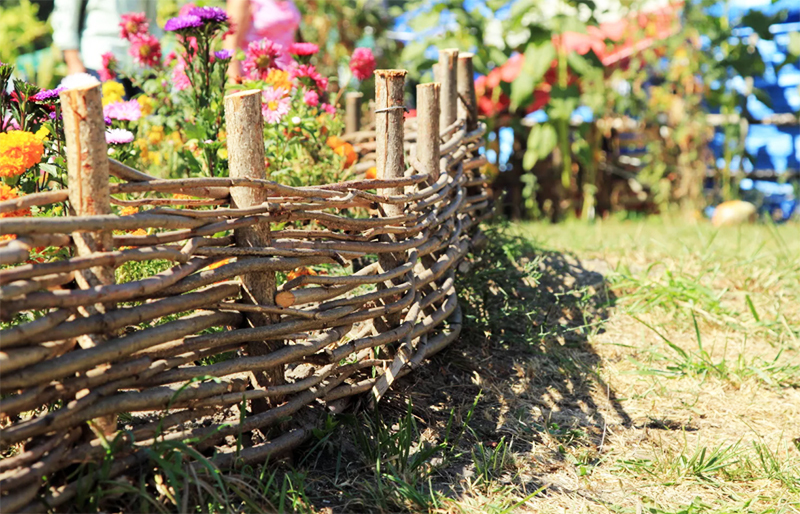
In order for the wattle fence to look dignified and serve for a long time, all shoots must be freed from the bark. There are various tools that make this process easier. If you want to make a large structure, it makes sense to look for or make a special knife for barking willow twigs. If the bark is not removed, after a while it will begin to fall off in pieces, which will look unattractive.
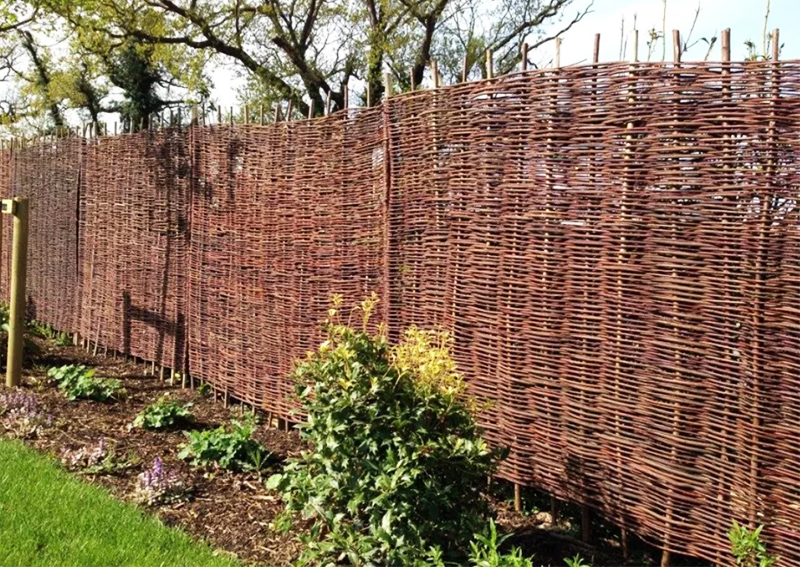
All this work takes time, so if you have collected a vine, but there is no time to mess with it yet, the shoots from the tree should be placed in basement, dark and dry place, and when the time comes, put the rods in water for a week so that they pick up moisture and become elastic. The longer you soak the branches, the easier it will be to remove the bark from them. This can be done not even with a knife, but with a split branch. The process will go even easier if you hold the bars over the steam. This is best done in a flooded bath if you have the opportunity.
Wicker fence posts
The main load is on the pillars. In a wicker fence, they act as a frame and support, so you need to carefully select materials for them. It is possible, in principle, to use thick even branches for such a fence, but in this case they must be at least 5 cm in diameter. Such branches are also barbed and treated with antiseptics.
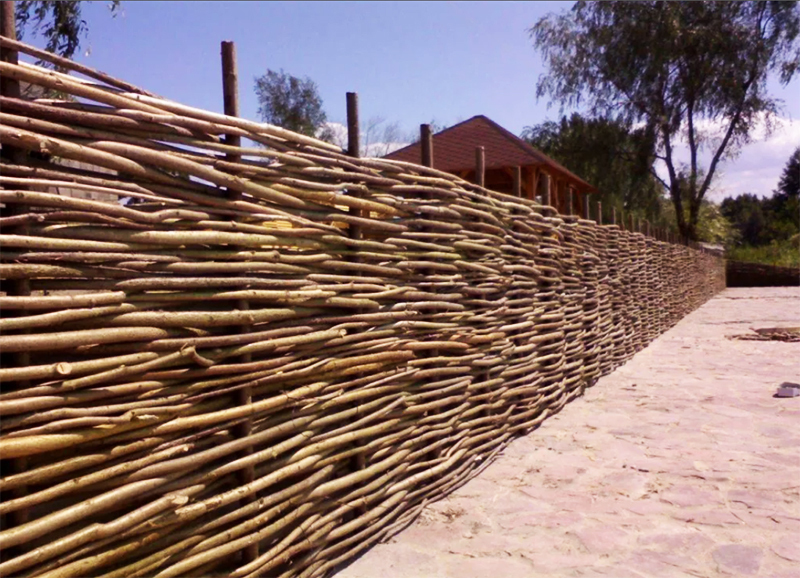
The installation depth in the ground is not less than half a meter. It is recommended to burn the ends of the pillars in a fire and dip them in hot bitumen so that they do not rot in the ground.
But it is best to use not branches or even timber, but metal pipes. Moreover, if the weaving of the fence is horizontal, it is worth giving preference to a round pipe. For a model with vertical weaving, it is worth choosing a profile pipe, because it is much easier to attach crossbars to it.
Fence weaving options
The simplest weaving option is horizontal. Its technology is simply entwining vertical supports with branches, in which the step alternates in each row.
Plain horizontal weave
No special instructions are needed here. In order to make a simple horizontal wattle fence, prepare vertical racks. Drive the posts into the ground with a distance between them of no more than 50 cm. If you use metal posts, they should be concreted into the ground at a depth lower than the freezing level.
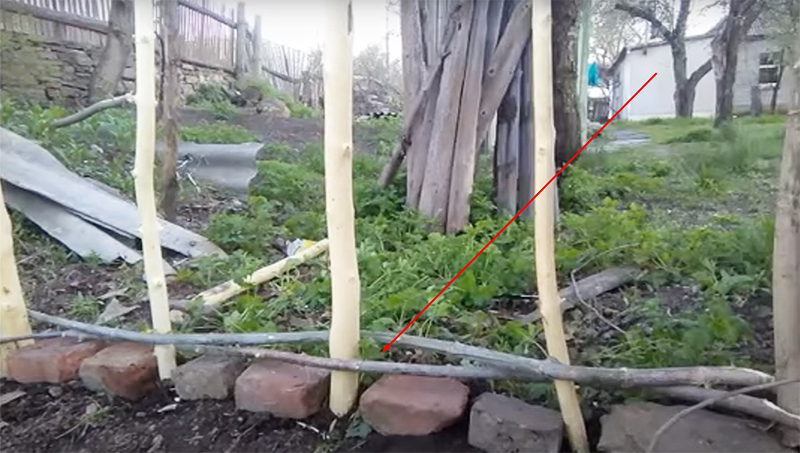
If you have a long fence in mind, and there is not enough rod to reach the end, the junction should be located on a pole.
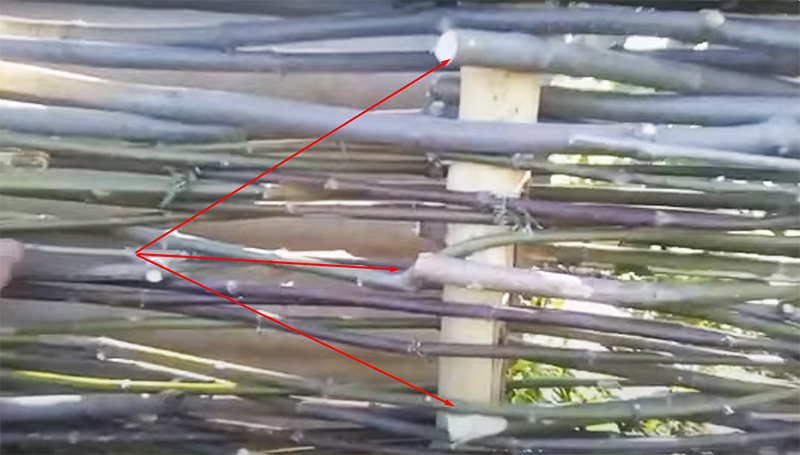
The second row is laid in exactly the same way, only pay attention to the fact that each vine has a thick and thin end.
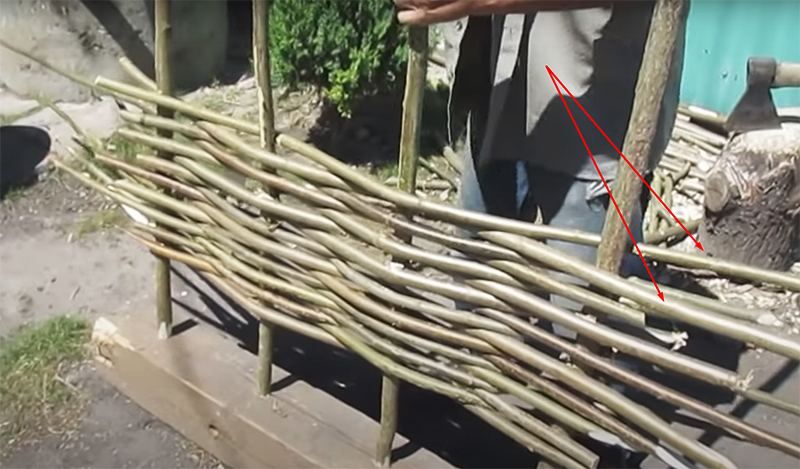
Continue weaving in this order, trying to ensure that the joints of the vines do not fall on the same post all the time. Every 3-4 rows, you need to lightly tap the braid with a mallet to seat the branches more tightly.
In this way, you can weave a fence in a circle, make one small section or build a shield, which can then be inserted into a stone base. In order for the shield to hold firmly, it is better to fix the edges of the branches with small self-tapping screws.
What is the secret of vertical weaving
Fundamentally, vertical weaving does not differ from horizontal. The difference is only in the direction of the supports.
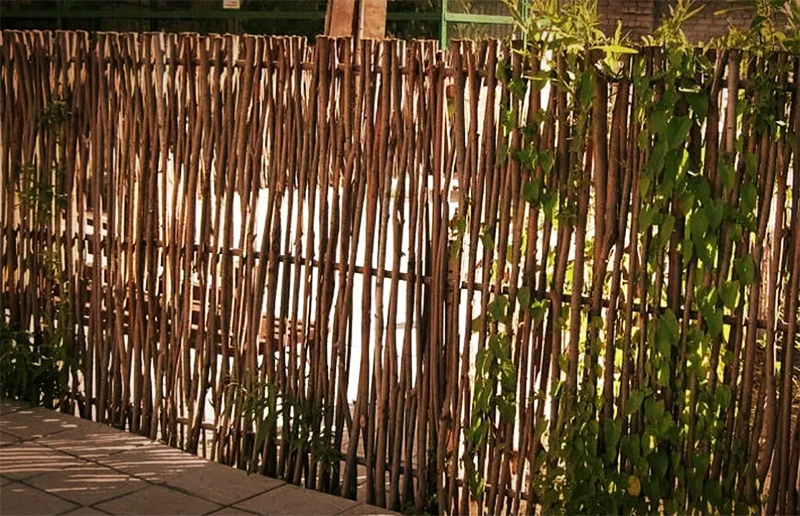
It is necessary to make a frame, and in this case it will be much easier to work with a profile pipe. It is fastened across vertical racks with the same distance of 50 cm as with horizontal weaving.
It’s even easier to make a vertical wattle fence - you don’t have to join the vine here. Usually a vine length of 120-150 cm is enough for a fence. In vertical weaving, in principle, docking is difficult - think about it in advance.
Masters recommend attaching a vine or boards to the base at the bottom of the vertical wattle fence. This will help them not to fall out during severe drying out in the hot summer.
Unusual options for weaving a fence
In vain, many believe that a wicker fence can only carry a decorative value. In fact, it is not transparent and quite durable - just what is required of a fence in a private house. And with a serious approach, you get a durable product.
If you already have experience in working with a vine, you can not be limited to primitive options with horizontal or vertical weaving. If you do not know how to weave, look at the patterns for baskets. You can use the same techniques, but there are a lot of patterns and types of weaving: pigtails, checkerboards, and weaving with gaps.
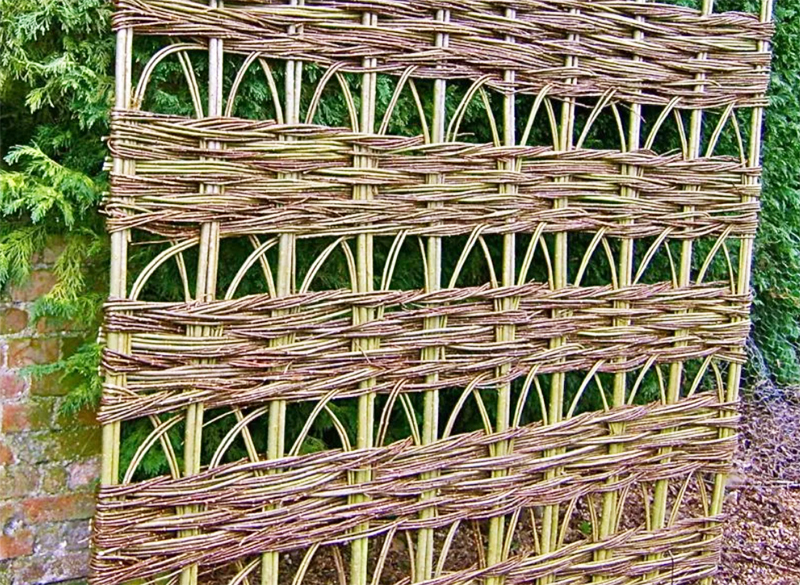
And another amazing way, proven by centuries of experience, to get not only an unusual, but also an incredibly strong fence from the same willow branches. As you know, willow takes root very easily, literally takes root with a branch stuck in the ground. The main condition is good humidity, it is not for nothing that willows prefer the banks of rivers and lakes. So you can make a living fence. To do this, freshly cut willow branches are stuck directly into the ground in the fall. In the spring, the shoots will take root and begin to grow.
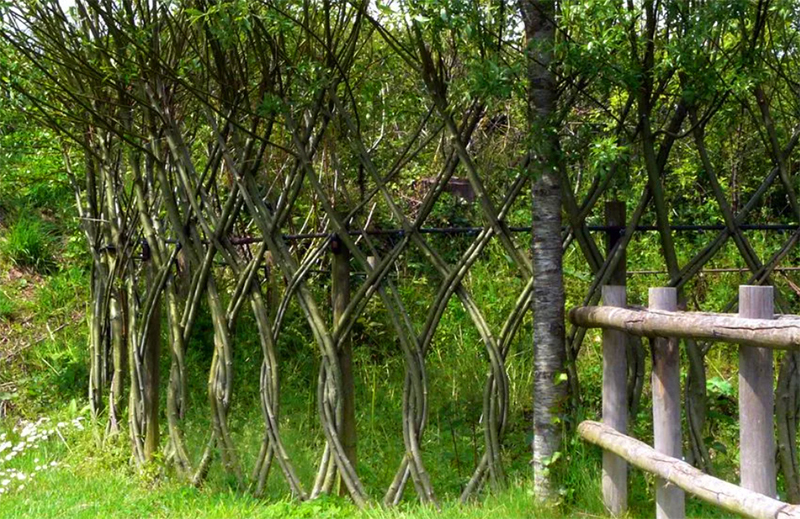
Cut off excess branches, form a fence to give the desired height and shape. In two seasons you will have a fence that will not stand firmly on the poles, but on the roots.
This hedge is trimmed regularly to keep its shape. Some stop growing by watering the trees with chemically active substances. Willows are dying, but the fence will stand for a long time.
Examples of wicker from different materials
Wicker fence can be made from different materials. As already mentioned, a great option is a thin board. Such material is relatively inexpensive, and the fences from it are simply gorgeous. Moreover, both in vertical, and in horizontal, and in diagonal weaving.
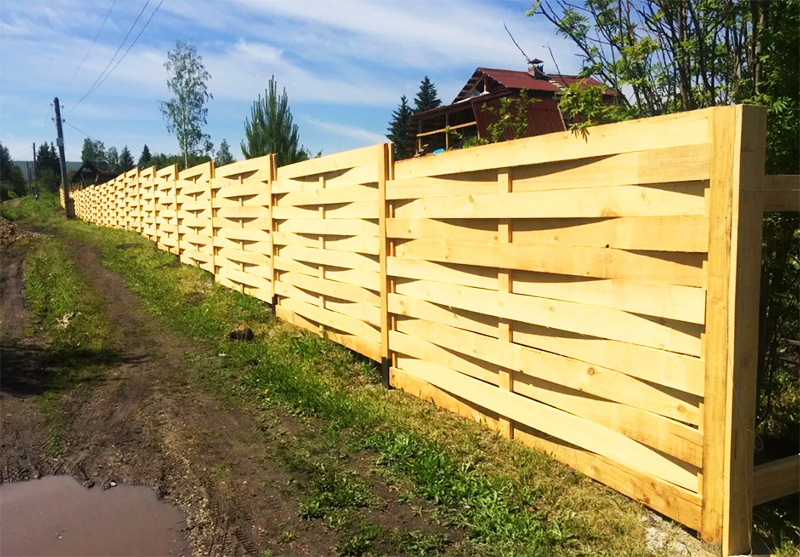
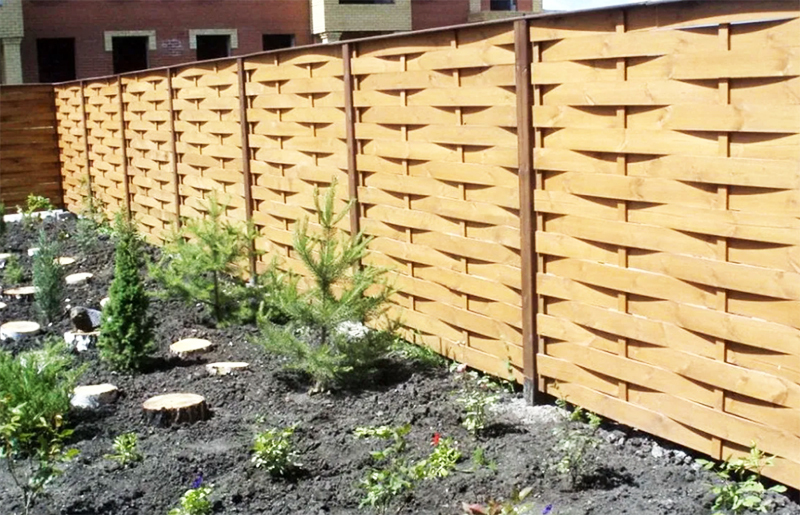
Another available material for making wattle is reeds or cattails. This is an affordable raw material that is easy to get with your own hands, and completely free.

Care and decoration of a wicker fence
In order for the wattle fence from branches or boards to last as long as possible, it should be pre-treated with stain and varnished after assembly. The best option is yacht, it will protect the tree from drying out and moisture.
The lowest rows that may come into contact with the ground should be painted over with hot bitumen or waterproof paint.
As for decorating the fence, it looks great on its own and in most cases does not need any additional decoration.
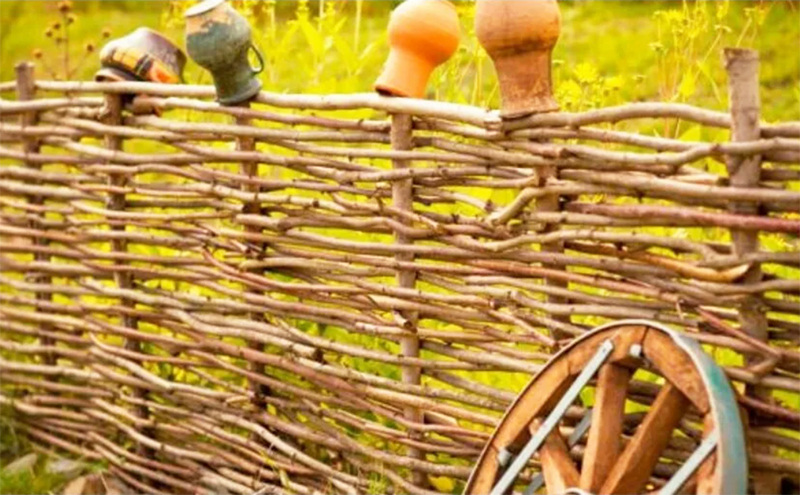
And in addition - a very clear and simple video tutorial on how to weave a fence from a vine from different trees:
How did you like this idea? Have you tried braiding and how did it work? Describe your experience in the comments!
Hello, my name is Andrey. I am buying information sites. There is…
and if the top layer of foam is not broken, then the lacquer surface greatly reduces the hygroscopic ...
strange reasoning regarding sealing. If the log is doused with sealant, foam ...
In the 80s he worked in one NPO, then hammer enamel was sintered. It turned out great,...
While in the summer I lived in the country a lot of different situations I saw and no one fines anyone. Uch…
You won't find a normal apartment for such a sum in Moscow. Even for a country house that …
Thank you. Briefly and clearly...
Karting. I want to help children! &nbs …
Now there is a very interesting and effective option for heating - plasterboard pas …
Everything is chic, but the emphasis is always on the ratchet. And for me, for example, it is technologically not p ...
yes indeed. you won’t call them later for the whole year no one appeared, they began to hear ...
And why sheathe the house initially with vapor barrier? What is its meaning? To create a conden…


